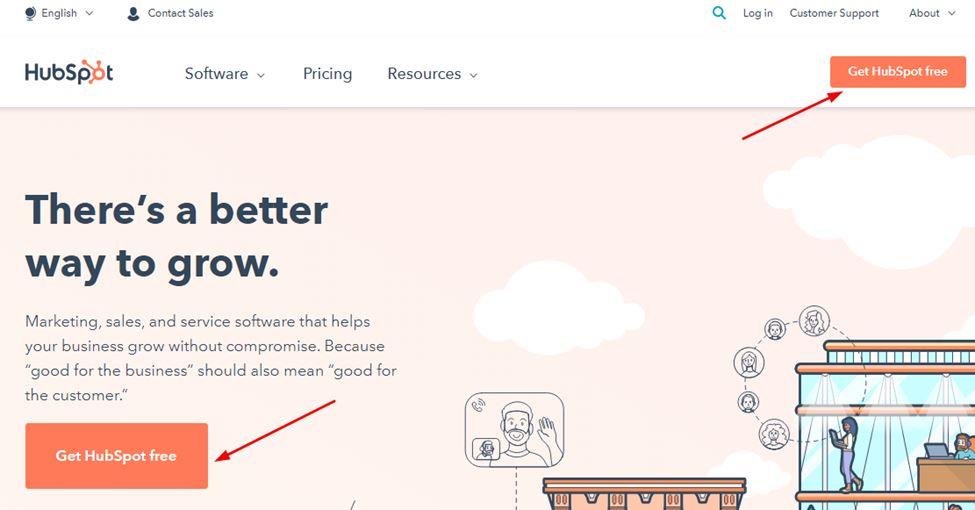
If you want to grow your business, it’s important that you increase your leads. Your lead generation strategy should involve convincing your website visitors that they are making the right choice by interacting with your brand. Lead generation is all about nurturing and growing a following. It involves building relationships that deliver short and long-term value for your business.
But optimizing your website for lead generation is not easy. It’s a long-term process that involves attracting, engaging, and converting most website visitors. The process typically starts when a visitor clicks on your website, and it doesn’t stop until they interact with your products and services.
So, here’s a guide on how to get and nurture more leads from your website.
1. Include Visible CTAs to Get More Traffic
Visitors can convert from different areas on your website. They can be reading a blog post and decide to fill a contact form to get more details about your brand. Some may have just landed on your home page and still click the first call-to-action. It’s for this reason that including a CTA on all your pages is excellent for lead generation.
But first, get to understand your audience. It’s necessary to perform an audit on pages they visit to discover actions that they take. For better results, carry out an audit on pages that bring the most leads. You can then create forms with information on topics that nurture relationships in top-performing pages.
If, for example, you discover that most visitors going to your blog posts request for product demos, you can include a contact form for an email subscription. You can then share links to content with video descriptions of your products and services through the email list. This way, you engage your audience by allowing them to convert when they want and at the place they find convenient.
A good example of visible CTAs is this one here by Hubspot

2. Automate Your Lead Generation Process
Automation is one of the top tactics for getting more leads from your website. With over 70% of businesses reporting better-targeted customer communication with automation, it’s no wonder it holds such relevance. With automation, you are sure that visitors coming to your pages still get valued services at varying periods.
For your company, this translates to successful lead generation with minimal human interactions. Automation will not only save you time but also money. The best part about automation is that you get the expertise and leads at reduced staff-hour and with no time restrictions.
3. Optimize Website for Online Visibility
Where you appear on search engines affects your lead generation processes. With 67.60% of all clicks going to the first five pages on the organic results, it’s important that you appear on the topmost part to improve your conversion rates.
It’s for this reason that your first step to improving your online visibility is in Search Engine Optimization (SEO). There are several aspects you should consider in your SEO strategies. First, you need to optimize your title tags, content, and meta descriptions for targeted keywords. If, for instance, you sell baseball caps, make sure that the term appears in most of your descriptions.
Also, remember to include keywords naturally in your content. Placing keywords in the right places will make it easy for search engines to crawl and rank your pages. The result of this is getting more traffic and closing more deals.
A point to note with optimizing your website is that it is a continuous process. This means that any changes in trends or Google Algorithms may affect your placing. So, make sure to stay up-to-date with the latest digital marketing news.
4. Optimize Each Aspect of Your Lead Generation Process
Your lead generation process does not end with optimizing your website. It involves other aspects like your landing page that help visitors convert. Through a landing page, you can create a conversion path that determines what works for your visitors. A conversion path will also inform most aspects of your web design that affect lead generation.
For better success in your processes, consider carrying out an A/B split testing. An A/B test will help fine-tune your strategies to see what performs best on each page. If, for example, your current landing page doesn’t seem to be bringing in enough visitors, you can create two other versions with different aspects to see what works. From the results, you can change headlines, images, or text to emphasize aspects that bring the most leads.
5. Improve Your Social Media Engagements
A lead generation goes beyond the website. It also involves social media platforms that attract visitors to your website. To create valuable leads on social media, you need to understand the channels most beneficial to your business.
For example, a B2B business dealing with business executives would thrive on LinkedIn and Twitter. But a travel enthusiast with lots of images to share would do well on Instagram or Facebook. It’s all a matter of what each social media platform is good at. And although both examples would still grow in either channel, specialization helps in targeting profitable leads.
The best part about social media is that it offers affordable lead generation techniques. It’s also convenient for attracting a large audience with quality and quantity content. The use of hashtags and viral content is relevant for pushing more traffic to websites.
6. Create an Excellent User Experience

A website speaks a lot about your business. It not only educates but also encourages visitors to purchase your products or services. If your website is user friendly, you encourage visitors to convert and come back for more.
But for a website to convert, you need to look further than the looks. You need to assess the usability, functionality, and reliability of every aspect of the page. If, for instance, a person with a disability is accessing your website, you need to ensure that they would move from page to page and get accurate details from your website.
That’s why a reliable website should factor in various UX elements. For a start, test the colors, design, and fonts to get a feel of what your visitors want. If there are varying results, pick designs that keep most visitors on your site.
Make sure that speed and mobile-responsiveness are also considered in your web designs. Improving your UX elements will ensure that leads can engage and convert faster on your website.
7. Deliver Valuable Content
Your content should educate, inform, and interest your readers. If it’s not doing this, you might be losing leads to a website offering valuable content. For content to be relevant, make sure you understand your audience.
You can know your visitors by researching their demographics, geographies, or browsing habits. From this information, you can develop a content strategy that answers your visitors’ questions.
Let’s say you own a pest control business. You carry out your research and discover most local searches include the terms “fire ants”. From your results, you can create a content plan answering most questions about fire ants. With the right keywords and structure, you will attract visitors to your website and encourage them to work with your pest control business.
8. Analyze the Performance of Each Lead Generator
Analyzing your websites’ performance will illustrate what’s working for you. If, for example, you have been carrying out A/B testing on your landing pages, the metrics will indicate what aspects convert the best. When analyzing the performance of your page, here are factors you should look out for;
- The number of page visitors
- Page visitors from referral from other websites
- The average time a visitor spends on your page
- Contact form subscribers
- Total leads that converted from each page
- A users’ journey to conversion
From this information, you can develop a lead generation plan that repurposes or upscale your digital marketing efforts.
9. Nurture Relationships with Email
There are several ways you can nurture relationships through email. First is by introducing a product and guiding the subscriber through the lead processes. Another would be guiding a buyer through a purchase process if they already know about your products. In both instances, you make sure that the visitor gains information about your products and services and converts to a buyer.
For example, a business looking to introduce a new product can start by informing its email subscribers. They can include offers that set special prices for people that reserve the product before the official launch.
Using this information, a business can measure the reactions to the product. They can also develop new strategies that encourage more leads. The emails will also offer a platform for customers to get in touch and give feedback.
Nurturing relationships also involves delivering attractive emails. This could be through visuals or texts that encourage prospects to read your messages. Appealing emails boost open rates. They ensure that subscribers find conversion buttons in the shortest time possible.
Conclusion
Your business can get more leads from a website by following this guide. Lead generation involves showing customers why they should trust you with their needs. It’s a thought process that requires planning, engagement, and nurturing of relationships.
Chris Mcdonald has been the lead news writer at complete connection. His passion for helping people in all aspects of online marketing flows through in the expert industry coverage he provides. Chris is also an author of tech blog Area19delegate. He likes spending his time with family, studying martial arts and plucking fat bass guitar strings.